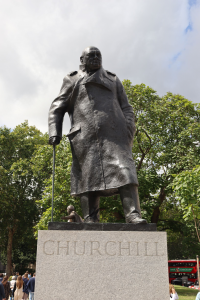Nick’s Churchill Fellowship: England, Ireland and Sweden
This blog details the last stages of my Churchill Fellowship adventures where I travelled to England, Ireland and Sweden.
After meeting with 50 experts in 66 days across 20 city and towns over five countries, my Churchill Fellowship has come to an end. I walked a lot – 1,116,503 steps, 938 kms – as it was a great way to discover each new location, get to meetings and provided an opportunity to reflect on what I had just learnt. It went amazingly fast and I am still attempting to digest all the experiences.
I really enjoyed travelling through the US (the country has at times been breathtaking) but was looking forward to reaching Europe. I landed in London and travelled straight to Bristol where I met with experts at the Bristol Zoo. One of these was Tim Bray who is assessing the feasibility of translocating the critically endangered Lemur Leaf Frog in Costa Rica. It was great to discuss some of the expertise I had gained from the IUCN Conservation Translocation training.

I also met Jen Nightingale who has been instrumental in conservation efforts for White-clawed Crayfish – the only native species of crayfish in the United Kingdom. White-clawed Crayfish is considered native, as it was recorded before 1500 AD in monastery records (evidence which was required for the species to be placed on the IUCN Red List of Threatened Species). The species has experienced widespread declines, due largely to the invasive Signal Crayfish and crayfish plague (a water mould that rapidly kills infected individuals). Fortunately, both threats are absent in Australia. Australian freshwater crayfish are susceptible to the plague, so let’s hope it never comes in. The strategy for White-clawed Crayfish conservation involves captive breeding (at Bristol Zoo), and the establishment of ‘Ark sites’. These isolated waterbodies don’t have such key threats to crayfish – they are similar to surrogate refuges we have successfully use for threatened native fish. Jen was fantastic, enthusiastic, hardworking (she has even established a crayfish hatchery in her back shed!) and knowledgeable. It was really interesting to see how much effort and resources has have been focused on a single crayfish species in the UK; it’s probably more than has been directed toward all 150 freshwater crayfish present in Australia combined!
Next stop was the National Lobster Hatchery in Padstow on the north coast of Cornwall, to meet Ben Marshall and Carly Daniels. They shed light on how this charitable organisation is almost exclusively funded by visitor fees (they get over 40,000 visitors annually). They ‘head-start’ 250,000 marine European Lobsters each year. The head-start process brings wild mature females with eggs into the hatchery. The eggs hatch, and are grown out for a month before release back to the wild. This increases survival during the crucial early life stages (recruitment failure has been an issue with wild populations). Although the hatchery focuses on a marine species, it is a fantastic model if we ever captive-breed freshwater crayfish in Australia.
I then flew to Dublin to meet with Emeritus Fellow Julian Reynolds at Trinity College Dublin, who has studied freshwater crayfish for more than four decades. Julian’s advice, in the face of many challenges, was to ‘enjoy the study of crayfish’. He was a very humble and supportive person.

Back in London, I met Brian Zimmerman, Chief Curator at the Zoological Society of London. Brian is passionate about the conservation of freshwater fish species, particularly those that are small and neglected. Fortuitously, I also visited the recently-opened freshwater fish public aquarium at Whipsnade Zoo. It is the first of its kind and Brian was influential in getting it off the ground. Again, inspiring stuff to raise awareness, if a country is serious about the conservation of native freshwater fish.
Lastly, I embarked on a trip to the Swedish island of Gotland in the Baltic Sea (it’s a one hour bus ride and three hour ferry trip from Stockholm) to present at the International Association of Astacology European Conference. The beautiful old town of Visby dates back to 900 AD (perhaps even longer) and is surrounded by the medieval city wall, most of which still stands. At the conference, I presented on our Murray Crayfish translocations, as well as the role of translocations in the conservation of freshwater crayfish under a changing climate; the latter talk was based on some of my discussions whilst on my Churchill Fellowship. It was great to attend a conference solely dedicated to freshwater crayfish and I met many interesting fellow astacologists.
So that’s it, my Churchill Fellowship travels are over, and now I’m travelling through Europe with my family. It has been said that a Churchill Fellowship is a lifelong journey of which your overseas travels are just the beginning. So to quote Winston Churchill, ‘… it is, perhaps, the end of the beginning’, and I look forward to sharing my experiences and lessons learnt when I return to Australia.
Cheers,
Nick.

